Polysiphonia
Polysiphonia- Systematic Position
Division: Rhodophyta
Class: Rhodophyceae
Order: Ceramiales
Family: Ceramiaceae
Distribution of Polysiphonia
Ø Polysiphonia is marine red algae belongs to the class Rhodophyceae.
Ø They are abundantly present in the Atlantic Coasts of America.
Ø Polysiphonia platycarpa is present in the Indian coastal regions.
Ø Polysiphonia violacea is an epiphytic alga grown on some brown algae such as Fucus vesiculosus.
Ø Some species of Polysiphonia are parasitic (example: Polysiphonia fastigiata).
Thallus Structure of Polysiphonia
Ø As the name suggests, the thallus of Polysiphonia is siphonous with many interconnected filaments (siphons).
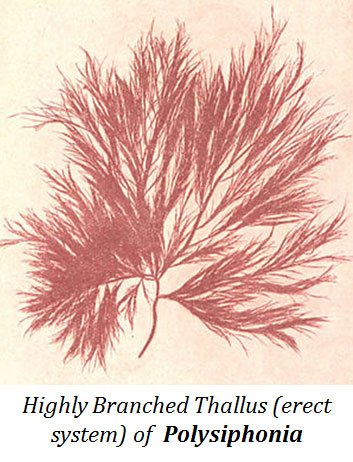 Ø The thallus color of Polysiphonia is varied from red to purple.
Ø The thallus color of Polysiphonia is varied from red to purple.
Ø The red coloration is due to the abundance of the pigment r-phycoerythrin.
Ø Other pigments such as chlorophyll-a, β-carotenes, Xanthophyll and r-phycocyanins are also present.
Learn more: Pigmentation in Algae
Ø The thallus of Polysiphonia consists of two systems:
(1). Prostrate system
(2). Erect system
(1). Prostrate System
Ø The prostrate system is creeping and basal.
Ø It is attached to a suitable substratum.
Ø The attachment is facilitated by well-developed rhizoids.
Ø Each rhizoid is single celled, thick-walled with swollen distal ends.
Ø These swollen distal ends of each rhizoids act as the attachment disc.
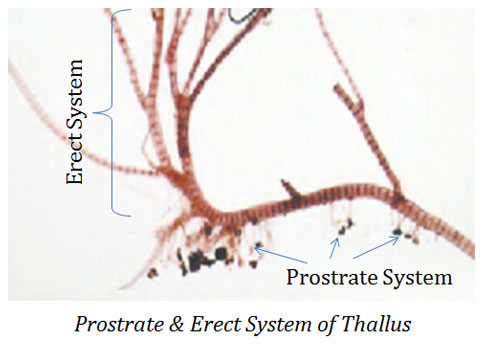
(2). Erect system
Ø The erect system is developed from the prostrate system.
Ø The erect system is vertical and profusely branched.
Ø The thallus of the erect system consists of several parallel filaments called siphons.
Ø The cells of each siphon are placed end to end and are connected by Plasmodesmata.
Ø Each cell of the siphon are genetically related.
Ø There are three types of siphons: (a) Central siphons, (b) Pericentral siphons and (c) Cortical siphons.
(a). Central siphons
$. The central siphon is located in the center of the thallus.
$. Cells of the central siphon are elongated and comparatively larger.
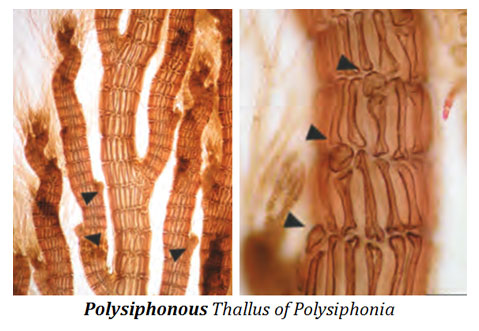 (b). Pericentral siphon
(b). Pericentral siphon
$. Peripheral siphon surrounds the central siphon.
$. Cells of the pericentral siphon are developed by the longitudinal division of the central siphon cells.
$. There are 4 – 24 pericentral siphons are present.
$. The number of pericentral siphons varies in different species.
$. The cells of pericentral siphon are comparatively smaller and narrow.
(c). Cortical cells (cortical siphon)
$. The cortical siphon is formed only in the older branches.
$. The cells of the pericentral siphon divide periclinally to produce many cells.
$. These cells are smaller than the pericentral cells.
Ø Plasmodesmatal connections are also present between the cells of central, pericentral and cortical siphons.
Ø Only a single siphon (central siphon) will be present in the apical portion of the thallus.
Ø The thallus of Polysiphonia shows apical growth which is facilitated by an apical cell.
| You may also like NOTES in... | ||
|---|---|---|
| BOTANY | BIOCHEMISTRY | MOL. BIOLOGY |
| ZOOLOGY | MICROBIOLOGY | BIOSTATISTICS |
| ECOLOGY | IMMUNOLOGY | BIOTECHNOLOGY |
| GENETICS | EMBRYOLOGY | PHYSIOLOGY |
| EVOLUTION | BIOPHYSICS | BIOINFORMATICS |
What are Trichoblasts?
Ø Trichoblasts are small mono-siphonous branches of the thallus with limited growth.
Ø Trichoblasts are developed from the apical initial cell.
Ø The apical initial cell undergoes an oblique division to form a trichoblast initial cell.
Ø The trichoblast initial undergoes many rounds of division to form the multicellular, uniseriate and dichotomously branched filaments called the Trichoblasts.
Cell structure
Ø The cells of Polysiphonia possess two-layered cell wall.
Ø The outer layer is pectic and the inner layer is cellulosic.
Ø Each cell is uninucleate with a viscous protoplast.
Ø The central portion of the cell possesses a large vacuole.
Ø The chromophores which bear the pigments are discoid.
Ø The reserved food material in Polysiphonia is Floridean starch.
Ø The floridean starch is distributed in the cytoplasm as small granules around the nucleus.
Ø Floridoside is also a food reserve in Polysiphonia.
Reproduction in Polysiphonia
Ø Polysiphonia reproduces by means of vegetative, asexual and sexual methods.
Ø Vegetative reproduction is by fragmentation of the thallus.
Ø Sexual reproduction is oogamous type.
Ø Asexual reproduction is by the production of Tetraspores.
Sexual reproduction in Polysiphonia:
Ø The life cycle of Polysiphonia is completed in three phases.
(1). Gametophytic phase (separate male and female plant)
(2). Carposporophytic phase
(3). Tetrasporophytic phase
Ø The life cycle of Polysiphonia consists of THREE plants
(1). Male Plant
(2). Female Plant
(3). Tetrasporophytic Plant
Ø These three plants are morphologically similar.
Ø The male plants bear antheridia which produce male gamete called spermatium (plural: spermatia).
Ø The female plant produces female sex organ called carpogonium (plural: carpogonia).
Ø The tetrasporophytic plant is the asexual plant which produces haploid tetraspores.
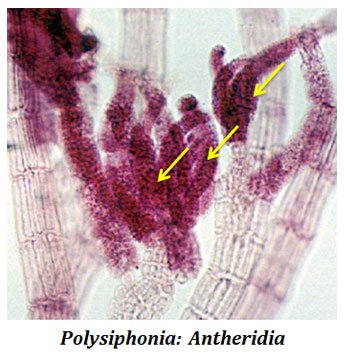
image source: wikipedia
Structure and Development of Antheridium in Polysiphonia
Ø The antheridium is the male sex organ.
Ø They are produced on the thallus of male plants.
Ø Antheridia produce the male gametes called spermatia.
Ø The antheridia are produced in clusters on the apical portion of some specialized branches.
Ø Each antheridial branch consists of a central trichoblast.
Ø The central trichoblast produces many lateral pericentral cells.
Ø Each pericentral cell develops many antheridial mother cells.
Ø In each antheridial mother cell, two to four antheridial cells are developed.
Ø These antheridial cells are called spermatangia.
Ø Each spermatangia produce a single spermatium or male gamete.
Ø Each spermatia (male gamete) is non-motile and uninucleate.
Ø The male gametes reach the female parts through the help of water current.
Ø After the liberation of spermatium, new spermatangia may develop on the old spermatangium.
Structure and Development of Carpogonium in Polysiphonia
Ø The female sex organ of Polysiphonia is called carpogonium.
Ø The carpogonium is developed on the thallus of a female plant.
Ø The young stage of carpogonium is called the pro-carp.
Ø The pro-carp is developed from a special cell of a reduced trichoblast.
Ø The pro carp consists of a row of 3 or 4 cells called carpogonial filament.
Ø Each cell of the carpogonial filament are connected by the plasmodesmata.
Ø The terminal cell of the carpogonial filament is narrow and elongated with a swollen base.
Ø The terminal narrow portion of this cell is called trichogyne and the swollen basal part is called carpogonium.
Ø The carpogonium possess the haploid female nucleus (female gamete).
Ø The cell below the carpogonium in the carpogonial filament is called the supporting cell.
Fertilization in Polysiphonia
Ø The fertilization in Polysiphonia is affected by the water current.
Ø The non-motile male gamete (spermatium) reaches the trichogyne of the carpogonium.
Ø The trichogyne is sticky. Thus the spermatium firmly sticks to the surface of trichogyne.
Ø The wall between the point of contact between trichogyne and spermatium dissolves and the male nuclei migrate into the basal carpogonium.
Ø The male nucleus fuse with the female nucleus situated at the base of the carpogonium to form the diploid zygote.
Ø After the fertilization, the trichogyne disintegrates and falls off.
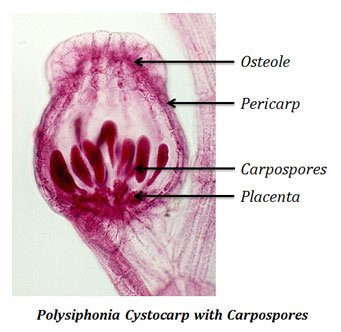
image source: wikipedia
Post Fertilization Changes in Polysiphonia
Ø Polysiphonia is characterized some specific and advanced events in its life cycle.
Ø These events occur after the fertilization and hence called the ‘Post-Fertilization Changes’.
Ø The post fertilization changes lead to the development of cystocarp.
Ø The cystocarp produce diploid carpospores.
Ø The supporting cell of the carpogonium produces an auxiliary cell on its upper side and just below the carpogonium.
Ø The auxiliary cell is haploid since it is developed from the haploid supporting cell.
Ø The auxiliary cell remains connected with the carpogonium with a tubular cytoplasmic connection.
Ø During this time, the diploid zygote in the carpogonium divides mitotically into two nuclei.
Ø Among these two nuclei, one migrates into the auxiliary cell through the tubular connection.
Ø The haploid nucleus in the auxiliary cell now degrades.
Ø Thus after the complete degradation of the haploid nuclei of the auxiliary cell, the cell now occupy the diploid nuclei migrated from the carpogonium.
Ø The diploid nucleus received by the auxiliary cell divide mitotically.
Ø They give rise to the development of gonimoblast initials.
Ø The gonimoblast rise from the upper part of the auxiliary cell.
Ø The gonimoblast contain many filaments, each cell of the filament possesses a diploid nucleus in it.
Ø The pericentral cell close to the supporting cell produce many vegetative cells.
Ø These vegetative cells ultimately develop into the diploid carpo-sporophytic plant.
Ø The carpogonium and trichogyne completely disintegrate.
Ø The diploid nucleus in the gonimoblast initial divides mitotically.
Ø Each of these nuclei will migrate into separate gonimoblasts.
Ø Each gonimoblast now contain a diploid nucleus.
Ø The terminal cell of each gonimoblast initial become swollen and functions as the carposporangium.
Ø The cell content of each carposporangium is differentiated into a single diploid carpospore.
Ø During this period, the supporting cell, auxiliary cell, carpogonial filament and sterile filaments fuse together to form an irregularly shaped nutritive cell called the placental cell.
Ø The entire structure consisting of the gonimoblast filaments, carposporangium, carpospores and placental cell are completely surrounded by young vegetative filaments.
Ø These vegetative filaments ultimately form the cup-shaped cystocarp.
Ø The cystocarp is actually the second phase of the life cycle of Polysiphonia called carposporophyte.
Ø The wall of the cystocarp is called pericarp and it contains an opening called osteole.
Ø The entire cystocarp is nutritionally dependent on the haploid gametophytic plant.
Ø Carpospores are liberated from the carpospores and they pass out through the osteole of the cystocarp.
Ø Each cystocarp many contain 50 – 60 carpospores.
Ø The carpospores germinate to form a new diploid phase called tetrasporophyte.
Ø The tetrasporophyte is the third phase of the life cycle of Polysiphonia.
Ø The tetrasporophyte resembles the gametophytic plant in their morphology.
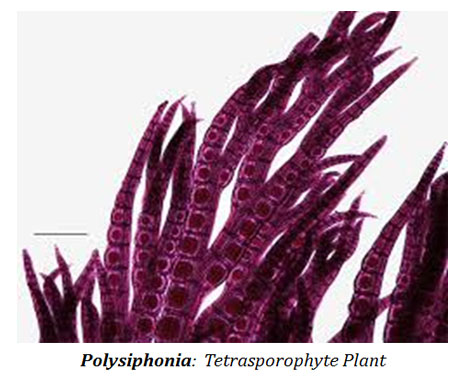
image source: cc wikipedia
Life Cycle of Polysiphonia
Ø The carpospores germinate immediately into a diploid plant called tetrasporophyte.
Ø The tetrasporophyte is a free living plant and it is similar to the gametophyte.
Ø The tetrasporophyte is a diploid plant which does not bear sex organs.
Ø It is an asexual plant which reproduces by haploid spores called tetraspores.
Ø The tetraspores are produced in tetrasporangia.
Ø The diploid nucleus of each of the tetrasporangium divides meiotically to produce for tetraspores.
Development of tetrasporangium in Polysiphonia
Ø The tetrasporangium is developed from the pericentral cells.
Ø These pericentral cells divide vertically to form an outer cell and an inner cell.
Ø The outer cell divide to produce two or more cover cells.
Ø The inner cell functions as the tetrasporangial mother cell.
Ø The tetrasporangial mother cell divides transversely to produce a lower stack cell and upper tetrasporangial cell.
Ø The tetrasporangial mother cell enlarges and functions as the tetrasporangium.
Ø The nucleus of the tetrasporangium divides meiotically to produce 4 haploid tetraspores.
Ø The sporangial wall ruptures and the tetraspore are liberated.
Ø The tetraspores germinate into the haploid gametophytic plant.
Ø Out of the four tetraspores produced from a single tetrasporangium, two develop into male plant and the other two developed into female plant.
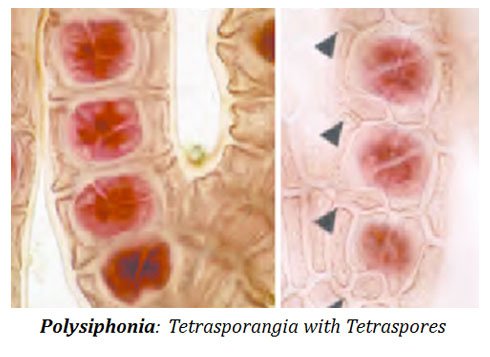
Polysiphonia Life Cycle
Learn more: Life Cycles in Algae
Ø The life cycle of Polysiphonia is triphasic consists of three phases.
Ø These three phases are:
(1). Haploid gametophytic phase
(2). Diploid carposporophytic phase
(3). Diploid tetrasporophytic phase
| You may also like... | ||
|---|---|---|
| NOTES | QUESTION BANK | COMPETITIVE EXAMS. |
| PPTs | UNIVERSITY EXAMS | DIFFERENCE BETWEEN.. |
| MCQs | PLUS ONE BIOLOGY | NEWS & JOBS |
| MOCK TESTS | PLUS TWO BIOLOGY | PRACTICAL |
Ø Thus the life cycle is with two diploid and one haploid phase and thus the life cycle of Polysiphonia is haplodiplobiontic.
Ø The gametophytic plant is haploid and they produce male and female gametes.
Ø The male gamete is called spermatium and female gamete is called carpogonium.
Ø Fusion of spermatium with carpogonium results in the formation of diploid zygote.
Ø From the diploid zygote, gonimoblast filaments with carposporangia arise.
Ø Each carposporangia produce single diploid carpospores.
Ø The carpospores producing diploid structure represent the second phase of the life cycle of Polysiphonia called Carposporophyte.
Ø The carpospores are germinated to produce the third phase called tetrasporophyte.
Ø Tetrasporophyte produce sporangium called tetrasporangium.
Ø Each tetrasporangium produces four haploid tetraspores.
Ø The tetraspores germinate into the haploid gametophytic phase and the lifecycle is completed.
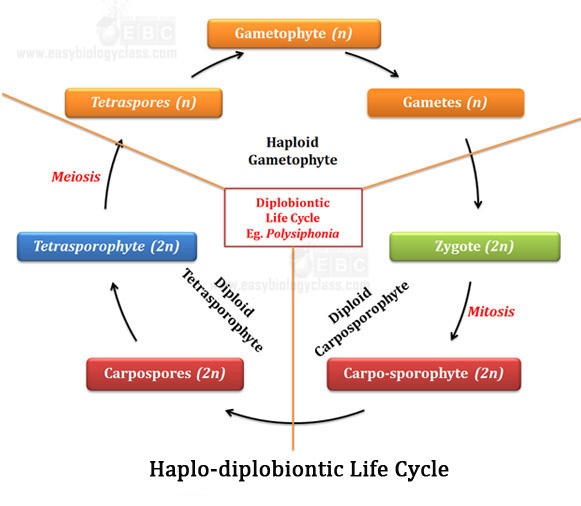
Haplo-diplobiontic Life Cycle (Eg. Polysiphonia)

Perfect and clear for all concepts.
I wasn’t able to get the concept. Then I visited this site and now I have a clear idea of it. 😊
Thank You Samikshya Hota
Keep visiting Easybiologyclass
This is my First visit And your way of writing is awesome awesome awesome Keep it up
Thank you Anju
Keep visit easybiologyclass
It’s not clear
please specify